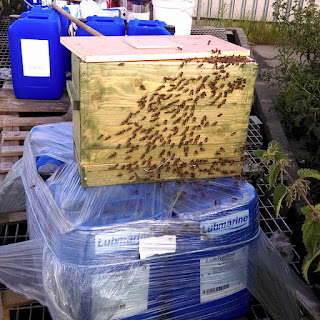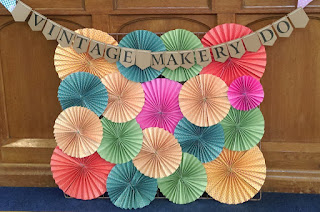 |
| Lots of nature around, but the bees chose this. |
My usual method of swarm catching involves initially getting as many bees as possible into the box at once by shaking or brushing them in. There wasn't space to do that with these though. Luckily the RBI had a different approach. He held the frame of old comb to the swarm and the bees walked on to it. They love the smell of brood and other pheromones in there.
 |
| Coaxing the bees onto the comb |
Once on the frame he shook it out into the Nuc then went back to the swarm with the old comb to get more bees and repeat. I'd wiped some swarm attractant into the Nuc -think that stuff's going to be a regular part of my kit after this year. The bees seemed to be staying in the Nuc once shaken in.
 |
| They seem to be staying |
 |
| In you go ladies. |
The Nuc was sat on top of 120 litres of Lubmarine (the marine lubricant used on over 7000 vessels!) and I'm not too sure what that contains so I was a bit careful with the smoker. Eventually with workers Nosanoving at the entrance we left the bees to finish getting themselves inside.
 |
| They're to the left |
The RBI gave me a thing called a Better Beetle Blaster to put in the hive. It's a trap for Small Hive Beetle (SHB). SHB is an African beetle which so far has caused huge problems to beekeeping in the USA and parts of Australia. As far as we know Small Hive Beetle hasn't made it to the UK but it reached Italy in 2014. Controls put in place to have included destroying complete apiraies where the beetle has been found and treating the ground around them. The Italian's scorched earth policy is understandably upsetting a lot of beekeepers there but left unchecked the beetle may cause far more damage and their efforts seem to be stopping the beetle spreading.
 |
| Better Beetle Blaster |
 |
| Beetle Blaster with oil in place in the Nuc. |
Back at the apiary I added some oil to the trap and popped it into the top of the Nuc then closed it up. Given the size of the colony and the calmness of the bees the RBI felt they had probably come from a nearby colony rather than a passing ship but given the impact Small Hive Beetle could have if it arrives it's best not to be complacent. He's told me to keep an eye on them for two brood cycles and I'll have a quick look in there next inspection.
The next day I got another call from Environmental Health reporting a second swarm in the same yard. Sometimes returning scouts can form a little cluster on the site a swarm was at if the person collecting it doesn't wait long enough for the scouts to rejoin the colony -ideally it's best to leave the box the swarm are going into till night time but that's not always doable. I was very sure I'd waited long enough though for the colony to get in so any stragglers wouldn't present a problem though. I grabbed another Nuc and went over. This time there was a smaller swarm very close to the previous days colony but in a slightly different place. Instead of being tucked under the pallet they were gathered on the corner of one the 20 litre lubmarine bottles. There were a couple of chaps curious as to how I was going to get the bees into my box (the Nuc) so I said I'd show them. Opening the box I placed it on top of the bottles with a view to using the old comb to gather the bees up and drop them in, but that didn't happen.
As soon as I put the box down the bees started running into it. Some went into the entrance others went running up the side for the opening at the top. All I had to do was wait. Never had such an easy swarm collection before. Whilst the previous day's swarm had included a number of drones this one didn't. I spoke to the RBI as once again they were the dock area and he felt they were most likely a cast swarm from the same colony that had produced the previous day's prime swarm. A cast swarm is a smaller secondary swarm sent out with a virgin Queen. I've taken them to my apiary and placed them next to the other swarm and on Monday the RBI will be dropping off another Beetle Blaster which I'll be adding some vegetable oil to and popping in the Nuc.
Talking to the guys at the ship repair place (impressive place with two dry docks BTW) swarms seem to arrive every year. One said swarms often come off the lumber ships going past to the unload at the docks which sounds very feasible so whilst checking swarms in the port and river bank area is making more work for our Inspector I'm inclined to think it needs doing. With the arrival of bees on passing ships and what may be a local feral colony in the area he may look into setting a bait hive up in the area to both keep an eye open for SHB and reduce impact of swarms - after all two swarms in two days must be quite annoying especially if they're holding work up by sitting on equipment that's needed.

















































